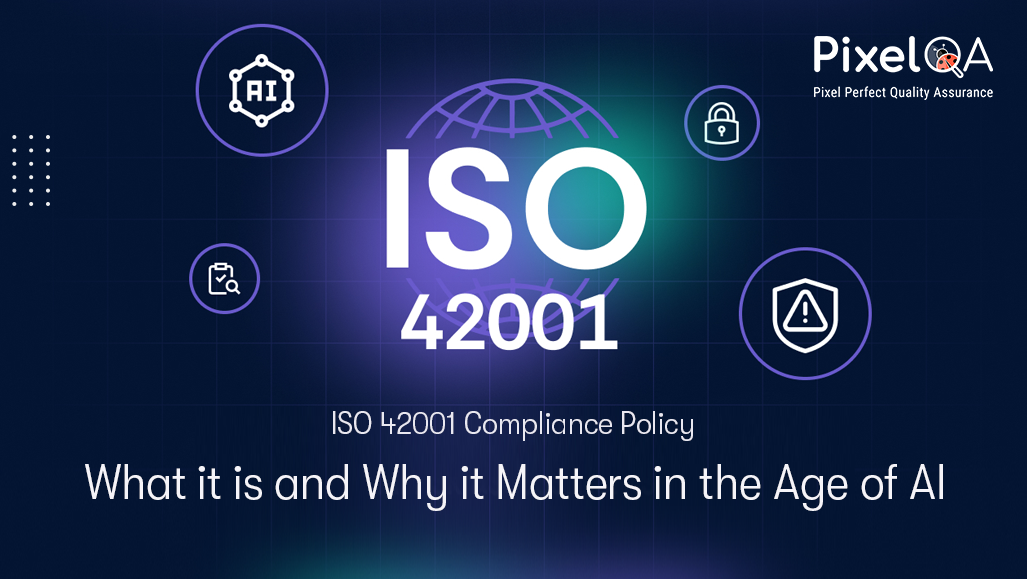
Development of AI and the Need for Barriers
Artificial intelligence is transforming nearly every aspect of modern life, from the way we shop online to the way businesses operate, make decisions, and deal with customers. Predictive analytics, self-service customer systems, customized recommendations, and even recruitment decisions are all examples of its impact. These developments are certainly exciting, and the possibilities appear limitless. But these innovations also pose important and unavoidable questions, especially for a System Testing Services ensuring the reliability and safety of AI-driven solutions.
Can we truly trust the systems we're leaving to make critical decisions?Are these AI systems acting in an obvious, safe, and neutral way? Just as critical, how can companies ensure that their AI isn't making decisions that could be illegal, immoral, or discriminatory?This is just as crucial.
ISO 42001 was developed to assist precisely with that sort of issue. ISO 42001, an accepted standard, gives businesses a systematic method of managing responsible AI design, development, and use. Think of it as a blueprint for ethical innovation, a paradigm that allows any business, not exclusively tech businesses, to develop AI systems that are stable, ethical, and compliant. The topic of how to decide if the AI systems your business is creating or using are working in accordance with your values, your stakeholders', your customers', and society's is discussed in SO 42001.
Table of Content
- What Is ISO 42001?
- Why is it so important for Business?
- The Core of ISO 42001: What It Covers
- Getting Started with ISO 42001
- Final Thoughts: Leading with Purpose in the AI Era
What Is ISO 42001?
The first globally recognized standard developed specifically for Artificial Intelligence Management Systems (AIMS) was ISO 42001, which was released in late 2023.
This is the AI equivalent of ISO 9001 for quality management or ISO 27001 for information security services.
Simply said, ISO 42001 helps companies
- Understand the risks and impacts of AI tools
- Put policies and controls in place to handle those risks
- Align AI systems with ethical principles and business goals
It’s not about stopping innovation, it’s about making sure your AI works for people, not against them.
Why is it so important for Business?
Let’s face it: AI can be a double-edged sword. A great recommendation algorithm can boost sales, but a biased hiring model could harm your brand overnight.
By adopting ISO 42001, companies can:
- Minimize ethical and legal risks
- Build credibility with clients and partners
- Get ahead of future regulations
More importantly, it shows that your business cares about doing AI the right way and that matters more than ever in today's transparency-driven market.
The Core of ISO 42001: What It Covers
While the full standard is detailed, here are the core areas it focuses on:
- Responsible Leadership
Your organization needs clear roles and responsibilities for AI oversight. This isn’t just an IT team issue leadership must be involved. - Risk Management
Before deploying any AI solution, companies are expected to identify risks to users, data, society, and even their own operations. - Data Governance
Good data = good AI. ISO 42001 stresses proper data handling, quality checks, and privacy protections throughout the AI lifecycle. - Transparency and Explainability
Can you explain how your AI system makes decisions? ISO 42001 requires organizations to make their systems more understandable and accountable. - Human Oversight
Even with advanced automation, the standard encourages keeping humans involved especially when AI decisions affect people’s rights or safety. - Ongoing Evaluation
AI systems evolve, so the way we manage them should too. ISO 42001 promotes regular audits and continuous improvements.
A Realistic Example: How This Applies
Let’s say you're running an e-commerce platform and using AI to recommend products. That’s great but are you:
- Making sure the system doesn’t show biased results?
- Protecting customer data behind the scenes?
- Explaining how recommendations are generated if asked?
ISO 42001 provides a roadmap to do all that not just once, but as a structured, ongoing process.
Getting Started with ISO 42001
If your business wants to align with this standard, here’s a simplified approach:
Step 1: Evaluate
Take stock of how you currently use AI and where the gaps are. What policies do you have? Where might risks exist?
Step 2: Design a Management System
You’ll need to create internal rules, define roles, document workflows, and ensure people understand their responsibilities around AI.
Step 3: Educate Your Teams
From developers to decision-makers, everyone needs to understand the “why” and “how” behind responsible AI.
Step 4: Monitor and Improve
Regular reviews, testing, and updates will help you stay compliant and avoid surprises down the road.
Step 5: Consider Certification
While certification isn’t required, it can help prove your commitment to clients, regulators, and stakeholders.
Why It’s Worth the Effort
You might be thinking, isn’t this just another compliance box to check? Actually, it’s a lot more than that.
Becoming ISO 42001-aligned can:
- Build customer trust
- Open doors to new business opportunities
- Help you stay ahead of AI-related regulations
- Protect your company’s brand and reputation
In a world where AI mistakes can go viral (and costly), having a solid foundation for responsible AI is simply smart business.
Final Thoughts: Leading with Purpose in the AI Era
Technology will keep advancing but responsibility should advance with it. ISO 42001 isn’t just a framework for controlling AI. It is a way to show that ethics, trust, and innovation are possible.
The time is now to begin looking at ISO 42001 if your business is committed to adding AI, either now or in the near future. Because being right is more valuable than complying with rules regarding AI.
About Author

Rushi Mistry is a Security Analyst at PixelQA a Software Testing Comapany with a focus on cybersecurity. He is passionate about IoT penetration testing and is working towards obtaining a CISSP certification, with the ultimate goal of becoming a Chief Information Security Officer (CISO).

_638802350121495466.png)